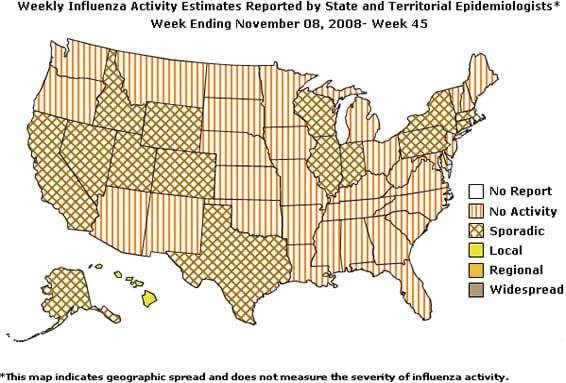Error processing SSI file
Weekly Report: Influenza Summary Update
2008-2009 Influenza Season Week 45, ending November 8, 2008
(All data are preliminary and may change as more reports are received.)Synopsis:
During week 45 (November 2-8, 2008), a low level of influenza activity was reported in the United States.
- Forty (1.7%) specimens tested by U.S. World Health Organization (WHO) and National Respiratory and Enteric Virus Surveillance System (NREVSS) collaborating laboratories, and reported to CDC/Influenza Division, were positive for influenza.
- The proportion of deaths attributed to pneumonia and influenza (P&I) was below the epidemic threshold.
- The proportion of outpatient visits for influenza-like illness (ILI) was below national and region-specific baseline levels.
- One state reported local influenza activity; 15 states and Puerto Rico reported sporadic influenza activity; 34 states and the District of Columbia reported no influenza activity.
Region |
Data for current week | Data cumulative for the season | ||||||
|---|---|---|---|---|---|---|---|---|
| Out-patient ILI* | % positive for flu† | Number of jurisdictions reporting regional or widespread activity‡ | A (H1) | A (H3) | A Unsub-typed | B | Pediatric Deaths | |
| Nation | Normal | 1.7 % | 0 of 51 | 49 | 11 | 94 | 37 | 0 |
| New England | Normal | 0.3 % | 0 of 6 | 0 | 1 | 0 | 1 | 0 |
| Mid-Atlantic | Normal | 0.3 % | 0 of 3 | 1 | 0 | 2 | 0 | 0 |
| East North Central | Normal | 3.3 % | 0 of 5 | 1 | 0 | 3 | 2 | 0 |
| West North Central | Normal | 0.3 % | 0 of 7 | 0 | 0 | 2 | 0 | |
| South Atlantic | Normal | 1.8 % | 0 of 9 | 3 | 2 | 28 | 11 | 0 |
| East South Central | Normal | 0.0 % | 0 of 4 | 0 | 0 | 0 | 0 | 0 |
| West South Central | Normal | 2.8 % | 0 of 4 | 5 | 0 | 18 | 11 | 0 |
| Mountain | Normal | 0.6 % | 0 of 8 | 0 | 6 | 5 | 3 | 0 |
| Pacific | Normal | 3.6 % | 0 of 5 | 39 | 2 | 36 | 8 | 0 |
* Elevated means the % of visits for ILI is at or above the national or
region-specific baseline
† National data is for current week; regional data is for the most recent three weeks.
‡ Includes all 50 states and the District of Columbia
U.S. Virologic Surveillance:
During week 45, WHO and NREVSS laboratories located in all 50 states and Washington D.C. reported 2,332 specimens tested for influenza viruses, 40 of which were positive: eight influenza A (H1) viruses, two influenza A (H3) viruses, 23 influenza A viruses that were not subtyped, and seven influenza B viruses. Twenty-one states from eight of the nine surveillance regions have reported laboratory-confirmed influenza this season.
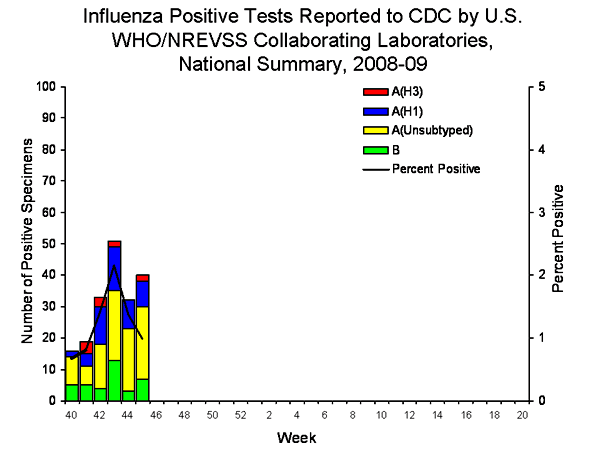
View Chart Data | View Full Screen
Antigenic Characterization:
CDC has antigenically characterized one influenza virus collected by U.S. laboratories since October 1, 2008. The influenza B virus was characterized as B/Florida/04/2006-like, belonging to the B/Yamagata lineage. Influenza B viruses currently circulating can be divided into two antigenically distinct lineages represented by the B/Yamagata/16/88 and B/Victoria/02/87 viruses. The recommended influenza B component for the 2008-09 influenza vaccine is a B/ Florida/04/2006-like viruses, belonging to the B/Yamagata lineage.
In addition, a small number of isolates from specimens collected during September were available for antigenic characterization: one influenza A (H1N1), two influenza A (H3N2), and four influenza B viruses. The influenza A (H1N1) specimen is antigenically close to A/Brisbane/59/2007, the influenza A (H1N1) component of the 2008-09 influenza vaccine. All six other viruses were antigenically similar to the components selected for the 2008-09 influenza vaccine (A/Brisbane/10/2007-like (H3N2) and B/Florida/04/2006-like).
It is too early in the influenza season to determine which influenza viruses will predominate or how well the vaccine and circulating strains will match.
Antigenic Characterization:
In the United States, two groups of antiviral drugs have been approved by FDA for use in treating or preventing influenza virus infections. These two groups of antiviral drugs are neuraminidase inhibitors (oseltamivir and zanamivir) and adamantanes (amantadine and rimantadine). A description of these drugs can be found at: http://www.cy118119.com/flu/protect/antiviral/index.htm.
Neuraminidase Inhibitor Antiviral Drugs: Since October 1, 2008, one influenza A (H1N1), one influenza A (H3N2), and one influenza B virus have been tested for antiviral resistance. In addition, CDC performed antiviral resistance testing on one influenza A (H1N1), three influenza A (H3N2), and four influenza B viruses collected during September. All tested viruses are sensitive to both oseltamivir and zanamivir.
Adamantane Antiviral Drugs: A small number of isolates from specimens collected during September were tested for adamantane resistance. The one influenza A (H1N1) virus tested and the two influenza A (H3N2) viruses tested were resistant to the adamantanes. The adamantanes are not effective against influenza B viruses.
Additional information on antiviral resistance can be found at: http://www.cy118119.com/flu/about/qa/antiviralresistance.htm
Based on the level of oseltamivir resistance observed in only one influenza subtype, H1N1, and the persisting high levels of resistance to the adamantanes in H3N2 viruses, CDC continues to recommend the use of oseltamivir and zanamivir for the treatment or prevention of influenza. Use of amantadine or rimantadine is not recommended. Guidance on influenza antiviral use can be found at: http://www.cy118119.com/mmwr/preview/mmwrhtml/rr57e717a1.htm
Pneumonia and Influenza (P&I) Mortality Surveillance
During week 45, 6.3% of all deaths reported through the 122-Cities Mortality Reporting System were due to P&I. This percentage is below the epidemic threshold of 6.8% for week 45.
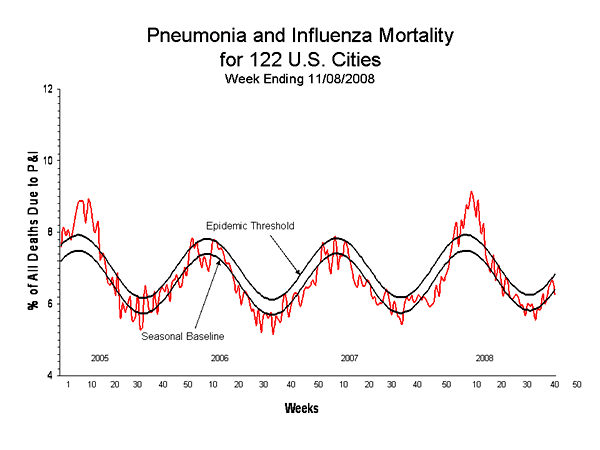
View Full Screen
Influenza-Associated Pediatric Mortality
No pediatric deaths have been reported for the 2008-09 season. One influenza-associated pediatric death was reported during week 45 from Washington. This death occurred during the 2007-08 season and brings the total number of reported pediatric deaths occurring during that season to 88.
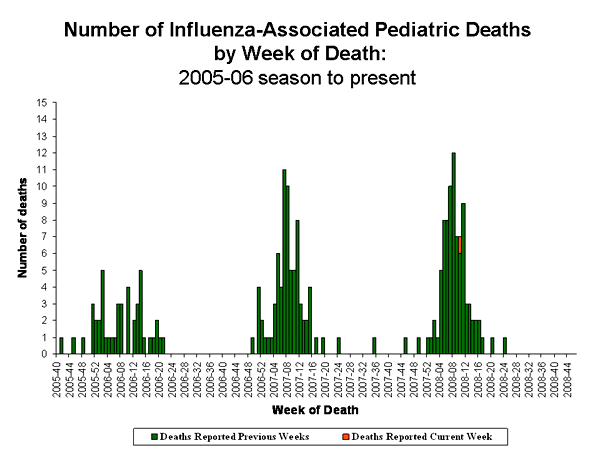
View Full Screen
Influenza-Associated Hospitalizations
Laboratory-confirmed influenza-associated hospitalizations are monitored in two population-based surveillance networks: the Emerging Infections Program (EIP) and the New Vaccine Surveillance Network (NVSN). EIP and NVSN estimated rates of hospitalization for influenza will be reported every two weeks starting later this season.
Outpatient Illness Surveillance:
During week 45, 1.1% of patient visits reported through the U.S. Outpatient Influenza-like Illness Surveillance Network (ILINet) (formerly known as the U.S. Influenza Sentinel Provider Surveillance Network) were due to influenza-like illness (ILI). This percentage is less than the national baseline of 2.4%. On a regional level, the percentage of visits for ILI ranged from 0.4% to 1.7%. All nine regions reported percentages of visits for ILI below their respective region-specific baselines.
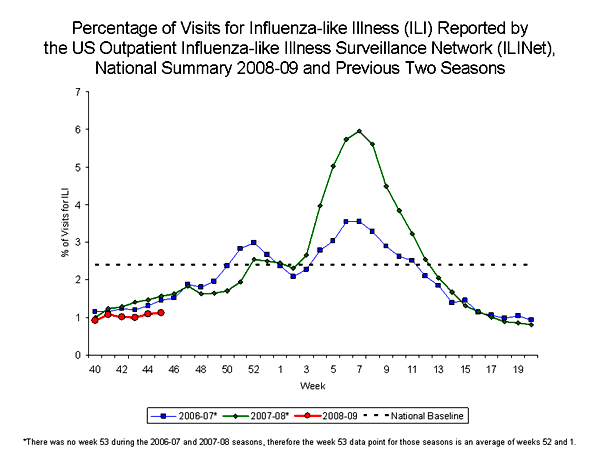
View Sentinel Providers Regional Charts | View Chart Data |View Full Screen
Geographic Spread of Influenza as Assessed by State and Territorial Epidemiologists:
During week 45 the following influenza activity was reported:
- Local influenza activity was reported in one state (Hawaii).
- Sporadic activity was reported in Puerto Rico and 15 states (Alaska, California, Colorado, Connecticut, Idaho, Illinois, Indiana, Massachusetts, Nevada, New York, Pennsylvania, Texas, Utah, Wisconsin, and Wyoming).
- No influenza activity was reported in the District of Columbia and 34 states (Alabama, Arizona, Arkansas, Delaware, Florida, Georgia, Iowa, Kansas, Kentucky, Louisiana, Maine, Maryland, Michigan, Minnesota, Mississippi, Missouri, Montana, Nebraska, New Hampshire, New Jersey, New Mexico, North Carolina, North Dakota, Ohio, Oklahoma, Oregon, Rhode Island, South Carolina, South Dakota, Tennessee, Vermont, Virginia, Washington, and West Virginia).
--------------------------------------------------------------------------------
A description of surveillance methods is available at: http://www.cy118119.com/flu/weekly/fluactivity.htm
- Page last updated November 14, 2008. Error processing SSI file
